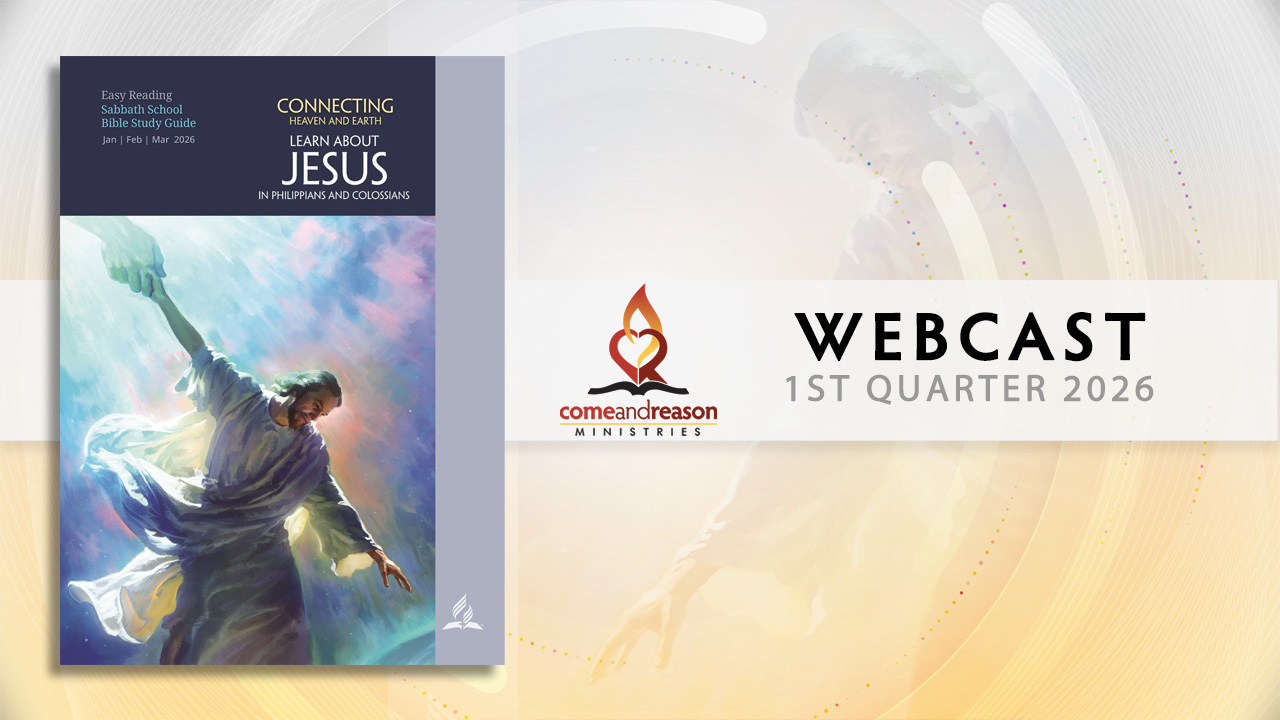In the Gospels, Jesus used the term “Son of Man” in reference to Himself 82 times. Why do you think Jesus used this term so frequently, and what do you think it means? Was Jesus trying to tell us something important?
Surely, Jesus wants us to know that He became a real human being who knows our struggles, empathizes with our difficulties, and understands our concerns. But is that all there is to His use of this term?
Could the title “Son of Man” be a statement about the Great Controversy? Could Jesus be using it over and over again because He wanted to say something about God’s purpose in creating humankind, about what human beings were to do in God’s order?
I am going to share with you a series of statements by E.G. White (EGW), who, in my estimation, was the most influential founder of the Seventh-day Adventist Church. And I believed that the most significant contribution she made to the body of Christian thought is the Great Controversy perspective—a wider view of the sin problem, one that extends beyond just human beings, one that also includes the heavenly realm from which a third of the angels fell. Christ’s mission to Earth included more than just saving human beings; it was also to eliminate sin from the universe and secure the unfallen beings in their loyalty so that sin would never arise again.
There are Bible texts that support this perspective. For instance, Jesus, speaking of His pending crucifixion, said:
But I, when I am lifted up from the earth, will draw all men to myself. (John 12:32 NIV84, emphasis mine)
The highlighted word “men” is not used in the Greek; it was inserted by the translators. That means Jesus was not saying that He would draw merely all humans to Himself, but that He would draw to Himself all intelligent beings still receptive to truth, whether those beings are on the earth or in heaven. The apostle Paul confirms this perspective:
For God was pleased to have all his fullness dwell in him [Jesus], and through him to reconcile to himself all things, whether things on earth or things in heaven, by making peace through his blood, shed on the cross (Colossians 1:19, 20 NIV84, emphasis mine).
We find the evidence for this greater universal war throughout Scripture:
- The serpent in Eden (Genesis 3:1)
- The angelic counsel in the first chapter of Job (vv. 6–12)
- Satan the accuser described in Zechariah chapter 3 (vv. 1–10)
- The temptations of Christ in the wilderness (Luke 4:1–13)
- The demoniacs that confronted Jesus (Mark 5:6–13)
- The war between Michael and the devil in heaven, when a third of the angels were cast out (Revelation 12:7)
EGW puts this larger view together in an incredible way, helping us see this greater universal landscape of the war, a conflict that centers on the character and trustworthiness of God.
So, back to my question—is Jesus’ use of the term Son of Man a Great Controversy statement?
Let’s consider a few EGW quotes. As you read them, think about whether her insights are reasonable. Are they consistent with Scripture? Do they give potential meaning as to why Christ used the term Son of Man so frequently?
After the earth was created, and the beasts upon it, the Father and Son carried out their purpose, which was designed before the fall of Satan, to make man in their own image. They had wrought together in the creation of the earth and every living thing upon it. And now God said to His Son, “Let us make man in our image.” As Adam came forth from the hand of his Creator he was of noble height and of beautiful symmetry (The Story of Redemption, p. 20).
In His foreknowledge and eternal wisdom, God had a purpose for the species human before Satan rebelled in heaven. What was that purpose? Let’s consider EGW’s view—do you agree or have a different conclusion?
When Adam came from the Creator’s hand, he bore, in his physical, mental, and spiritual nature, a likeness to his Maker. “God created man in His own image” (Genesis 1:27), and it was His purpose that the longer man lived the more fully he should reveal this image—the more fully reflect the glory of the Creator. All his faculties were capable of development; their capacity and vigor were continually to increase. Vast was the scope offered for their exercise, glorious the field opened to their research. The mysteries of the visible universe—the “wondrous works of Him which is perfect in knowledge” (Job 37:16)—invited man’s study. Face-to-face, heart-to-heart communion with his Maker was his high privilege. Had he remained loyal to God, all this would have been his forever. Throughout eternal ages he would have continued to gain new treasures of knowledge, to discover fresh springs of happiness, and to obtain clearer and yet clearer conceptions of the wisdom, the power, and the love of God. More and more fully would he have fulfilled the object of his creation, more and more fully have reflected the Creator’s glory (Education, p. 15).
Did God have a purpose in creating human beings? What would have happened if Adam and Eve had stayed loyal to God and governed the planet in harmony with God’s methods? How would they have treated each other in a sinless world? How would they have treated their children? How would they have treated the animals and managed the planet? Would this have revealed anything about how God governs His universe? Could God have a purpose in this? Could it have said something in the Great Controversy that would have refuted allegations of Satan?
Do you think Satan would have wanted this purpose for humanity’s creation to come to fruition? No! Thus, the evil one targeted our first parents. EGW suggests the following—do you agree?
As soon as the Lord through Jesus Christ created our world and placed Adam and Eve in the Garden of Eden, Satan announced his purpose to conform to his own nature the father and mother of all humanity, and to unite them with his own ranks of rebellion. He was determined to efface the image of God from the human posterity, and to trace his own image upon the soul in the place of the divine image (The Review and Herald, April 14, 1896).
God’s purpose for humanity was for us to be the repositories of His living law of love. God’s law cannot be fully understood on stone, for love requires life. Human beings were, therefore, created in the image of God to live out God’s law of love in governance of themselves and in how they treated others and governed the planet.
But Satan interfered with God’s plan. Satan is the father of lies and through his misrepresentation of God, he infected humanity with fear and selfishness. His goal is to erase fidelity, love, truth, integrity, honesty, loyalty, and all other virtues from the living temple, in which God placed His image and, instead, have human beings carry around his evil law of survival of the fittest, of me-first, of power, control, coercion, force, abuse, murder, and death.
That is why Jesus came as the second Adam! He sought to overthrow the infection of fear, selfishness, and sin that Satan had introduced into the heart and mind of Adam and Eve and to restore God’s image in us. EGW suggests the following as part of Christ’s mission—do you agree?
In assuming human nature, that he might reach to the very depths of human woe and misery and lift man up, Christ has shown what estimate he places upon the human race. In this work everything was at stake. Satan claimed to be the lawful owner of the fallen race; and with what persistent effort did he seek to overthrow Christ through his subtilty! It was only by the most desperate conflict with the powers of Satan that Christ could accomplish his purpose of restoring the almost obliterated image of God in man, and place his own signature upon his forehead. It was a desperate battle; for Satan had so long worked in league with human intelligences as to almost completely intercept every ray of light shining from the throne of God upon the human mind. The cross of Calvary alone could destroy the works of the devil. In that wondrous sacrifice all eyes were called to “behold the Lamb of God, which taketh away the sin of the world.” The love of Christ kindles in the heart of all who continue to behold him (General Conference Daily Bulletin, March 2, 1897, par. 17).
Thus, is it possible that Jesus used the term Son of Man because He is not just redeeming individual humans He loves, but also because He is redeeming the mission and purpose that God created humanity to fulfill?
And by doing this, Christ not only reveals the truth of God’s character of love, His design laws of life, but He also reveals that Adam’s sin was not because of a manufacturer’s defect! By His selfless victory while in the form of weakened humanity, Jesus proved that the sin of Adam was not because of some flaw in his design, or creation, or a lack of some resource.
Yes, Jesus is the Son of Man, the second Adam, who is our Creator, Savior, and Sustainer—the one who is worthy “to receive power and wealth and wisdom and strength and honor and glory and praise” forever and ever amen! (Revelation 5:12 NIV84).












 using your credit or debit card (no PayPal account needed, unless you want to set up a monthly, recurring payment).
using your credit or debit card (no PayPal account needed, unless you want to set up a monthly, recurring payment). instead?
instead?